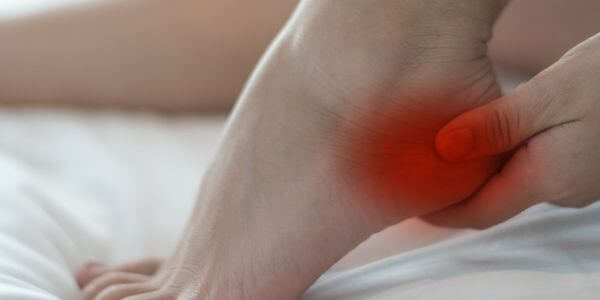
Painful sports injuries or pain caused by soft tissue or bone problems can be debilitating, difficult to manage and cause a great deal of stress and upset.
These conditions can impact the quality of your life and mean that you’re unable to exercise or do the things you enjoy.
You may have to take regular pain relief medication, which still doesn’t always relieve your pain and discomfort, and can cause you to develop side effects. Sometimes, surgery can seem like your only option, which is daunting and not without risk.
Shockwave therapy is an innovative therapy that can target specific pain in the bones, joints, muscles, tendons and ligaments. It’s a non-invasive treatment that can be delivered on an out patient basis and gives significant or total relief of pain in the vast majority of patients.
King Edward VII’s Hospital offers shockwave therapy and here, Consultant Foot and Ankle Surgeon Mr Lloyd Williams explains how the treatment works, what conditions it can be effective for and who might be suitable.
What is shockwave therapy?
Shockwave therapy is also known as Extracorporeal Shockwave Therapy (ESWT) or Radial Shockwave Therapy (RSWT).
The therapy isn’t new, but its use in the treatment of painful joints and muscles is a relatively recent development. Shockwave therapy was originally developed to help urologists treat kidney stones non-invasively, in the late 1990s. Now it’s successfully used to help treat many musculoskeletal conditions.
Multiple scientific papers have found that it can successfully treat conditions such as heel pain caused by plantar fasciitis, and Achilles tendinopathy.
There are no known side effects to having shockwave therapy. The National Institute for Health and Clinical Excellence, or NICE, who give guidance, advice and information to healthcare professionals, approves the use of shockwave therapy for musculoskeletal pain relief in clinic and hospital settings in the UK.
What conditions is shockwave therapy used for?

Shockwave therapy is beneficial for patients with painful soft tissue (muscle, tendons and ligaments), joint and bone conditions. The therapy can help those with sports or overuse injuries and can benefit those undergoing physiotherapy for a range of complaints.
Most commonly, shockwave therapy is used to help treat the following conditions:
- Achilles tendinopathy (pain in the tendon that connects the back of the foot to the calf muscle)
- Plantar fasciitis (pain in the underside of the foot)
- Tennis elbow (pain on the outer side of the elbow)
- Golfers elbow (pain on the inner side of the elbow)
- Patellofemoral syndrome (runner’s knee)
- Iliotibial band Syndrome, or ITBS (pain that stretches from the outside of the hip down the outer thigh to the outside of the knee caused by running and cycling)
- Medial tibial stress syndrome (shin splints)
- Bony heel spurs
How does shockwave therapy work?
Shockwave therapy is delivered directly onto the skin that covers the affected area. This kind of pain relief therapy uses low energy sound, or acoustic, waves, rather than electrical waves.
These sound waves are ‘radial’ in shape and behaviour. They can easily penetrate the skin, and once through, they radiate as a shockwave throughout the affected muscle, joint or tendon. Shockwave therapy is therefore a targeted type of therapy, only treating the areas that are injured or damaged.
When you go for shockwave treatment, your therapist will use a hand held device connected to a machine that turns compressed air into sound waves. They’ll apply some light pressure and move the device over the area that requires treatment. Ultrasound gel is applied to the skin beforehand to help transmit the shockwaves through the skin.
The sound waves stimulate blood flow to the area, and also causes a small amount of localised inflammation. In the days after treatment, the body will work to naturally heal this inflammation, and in doing so, stimulates the repair and regeneration of cells. Damaged or injured tissues then begin to repair and cause the associated pain to reduce.
If you have scar tissue in the area, that’s contributing to your pain, shockwave therapy will also help to break down this thick, fibrous tissue. Scar tissue causes immobility in the surrounding tissues as unlike normal tissues, it isn’t very elastic. Breaking it down using sound waves helps to improve mobility and discomfort.
Is shockwave therapy suitable for everyone?
Before having any treatment, your specialist will take a full medical history from you to assess your suitability for shockwave therapy.
Shockwave therapy is a safe, effective treatment if given in a professional setting, but there are circumstances where it isn’t advised. This type of treatment isn’t suitable if:
- You have a blood clotting disorder and/or take blood thinning or anticoagulant medications such as aspirin (75mg on a daily basis) or warfarin
- You have a nerve disorder
- You’re pregnant
- You have or have had any kind of bone cancer
- You have an infection in the area that needs treatment
- You have metal pins or plates in the area that needs treatment
- You’ve received a steroid injection for the same problem in the last 12 weeks
- You’ve taken any non-steroidal anti-inflammatory painkillers such as ibuprofen for any reason in the last two weeks
Your specialist will be able to advise the best course of action if any of the above apply to you.
Is shockwave therapy painful?
Shockwave therapy is a non-invasive, non-surgical treatment, but you might feel a little pain or discomfort in the treatment area during the procedure. Most patients say it feels like small pulses against the skin. Your specialist may be able to adjust the way they use the shockwave device if your pain is significant.
Each session will only last a few minutes, so the vast majority of patients are able to tolerate the levels of discomfort caused by shockwave therapy.
When you arrive for your treatment, it’s helpful if you’re wearing loose clothing that you can move around easily in as it will make you more comfortable. Depending on where your pain is, you may be laying on your front, and it’s easier to do so if you’re not restricted by clothing.
How long does it take to recover after shockwave therapy?
Once your treatment is finished, you’ll be able to go home and return to work and your normal daily activities straight away. You should avoid high impact exercise such as running or playing tennis for the first 48 hours after treatment.
If you feel any discomfort, you can take paracetamol if you’re able, but avoid taking a non-steroidal anti-inflammatory painkiller such as ibuprofen as it will counteract the treatment and render it useless.
In the days following shockwave therapy, you may experience swelling and redness in the treated area. This can make your pain feel worse, but this is indicative of the healing process, is completely normal and will subside within a day or two.
How soon will shockwave therapy work?
Most patients require three sessions of shockwave therapy, each a week apart, before significant pain relief is noticed. Some conditions may require five treatments. Your specialist will be able to discuss your particular case and expectations with you.
After your course of treatment is completed, your specialist will usually arrange to see you again to see how you’re getting on.
More information
- To enquire about shockwave therapy at King Edward VII’s Hospital, contact our friendly enquiries team on 020 3468 6807 for more information and to book a consultation.
- We also haev a specialist Sports and Exercise Medicine Unit that can help get you back on your feet and strong enough to train again and live your life without pain.
Article Sections
Latest Hospital News
Should you wish to speak to our press team, please visit Press Enquiries




